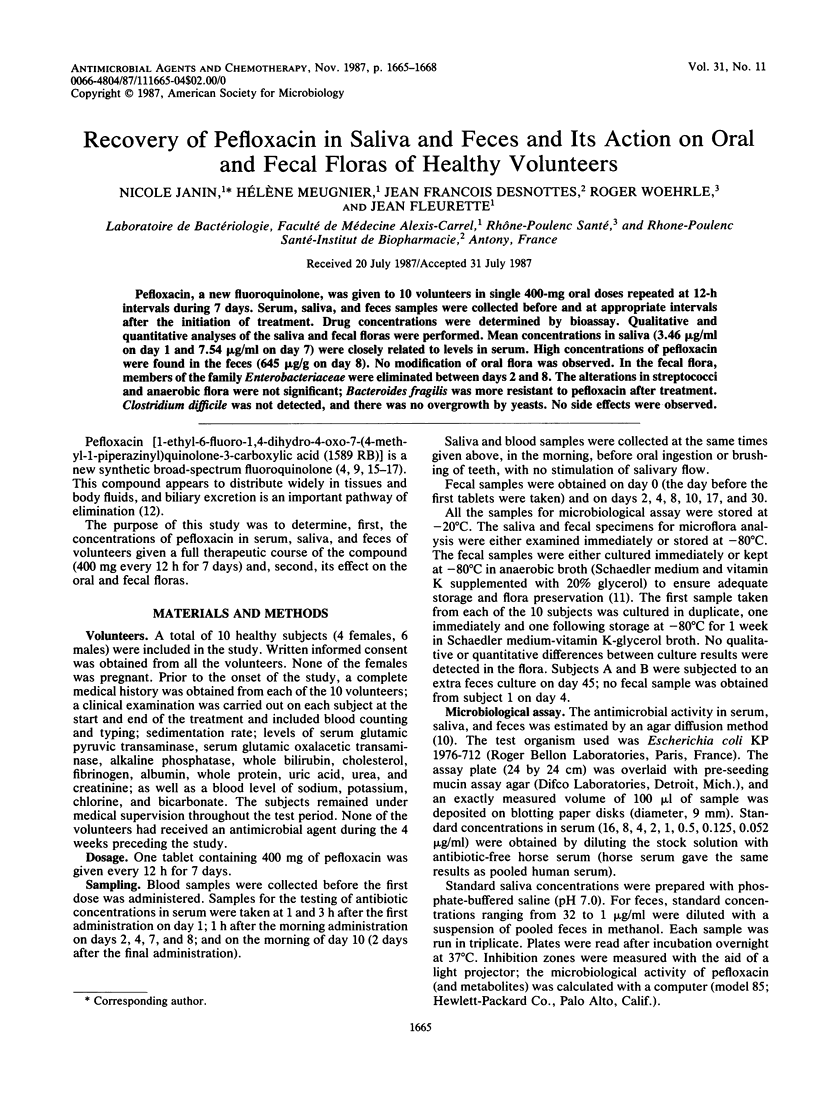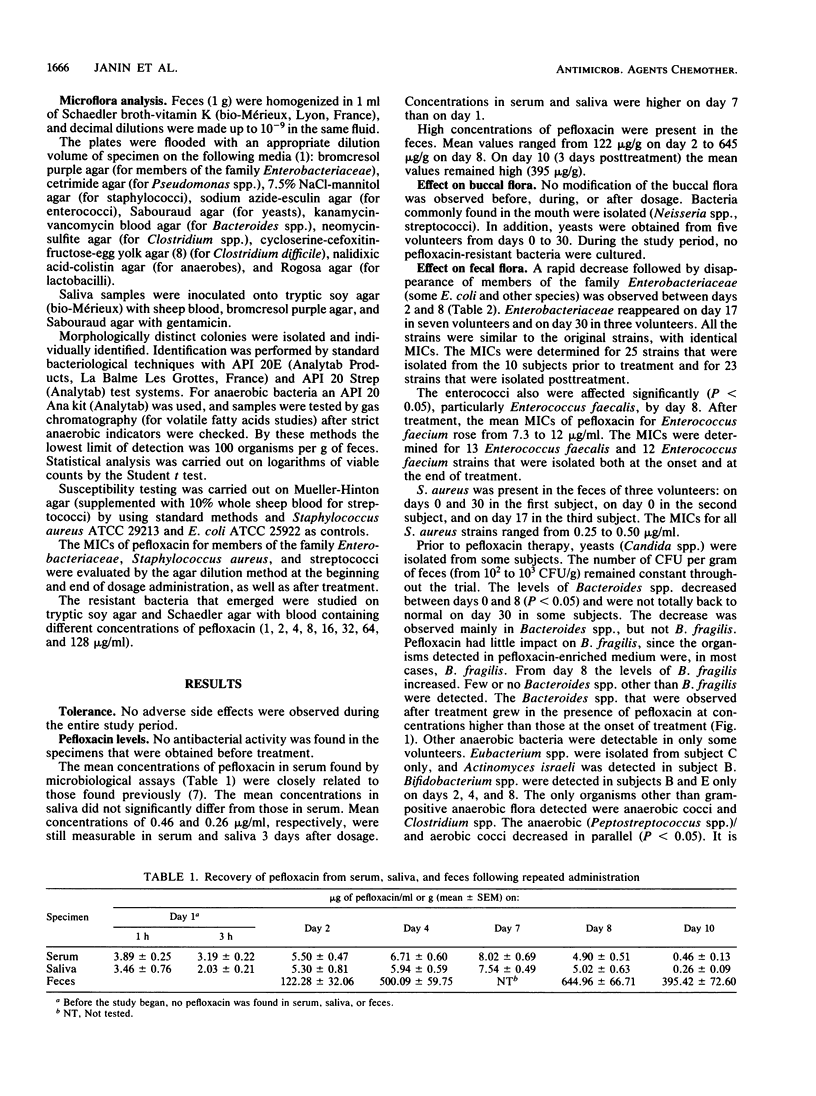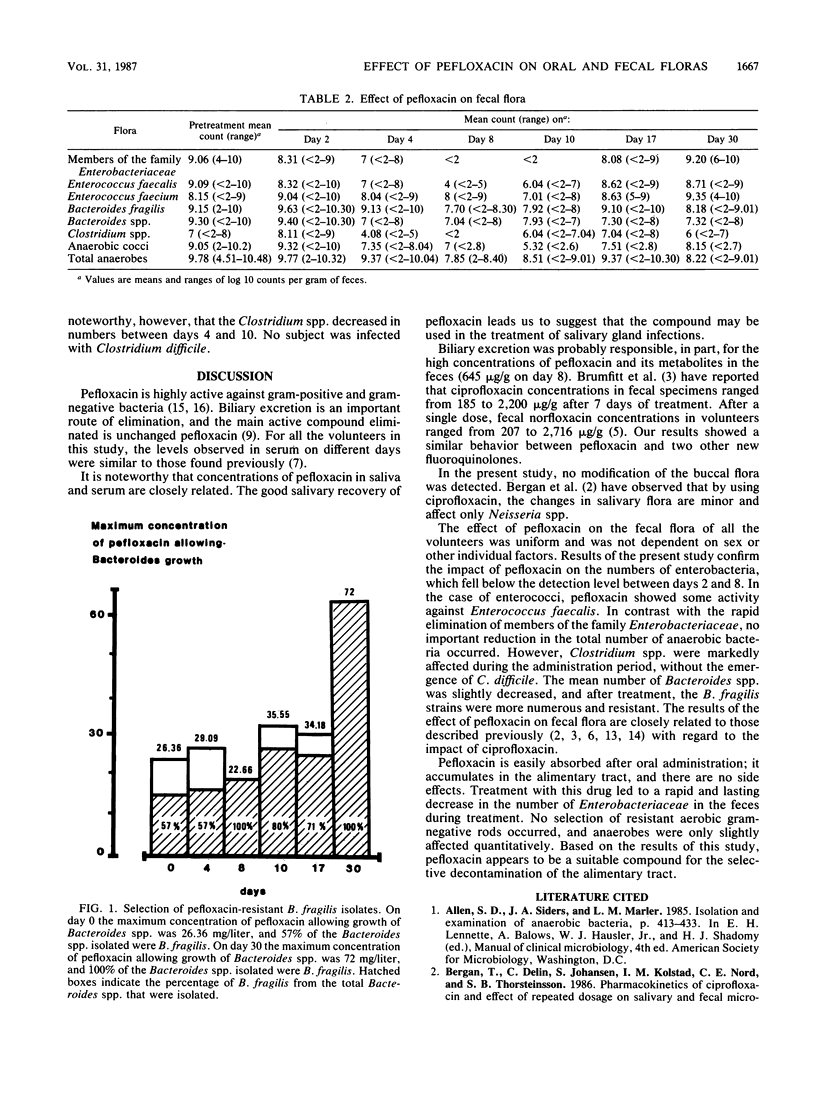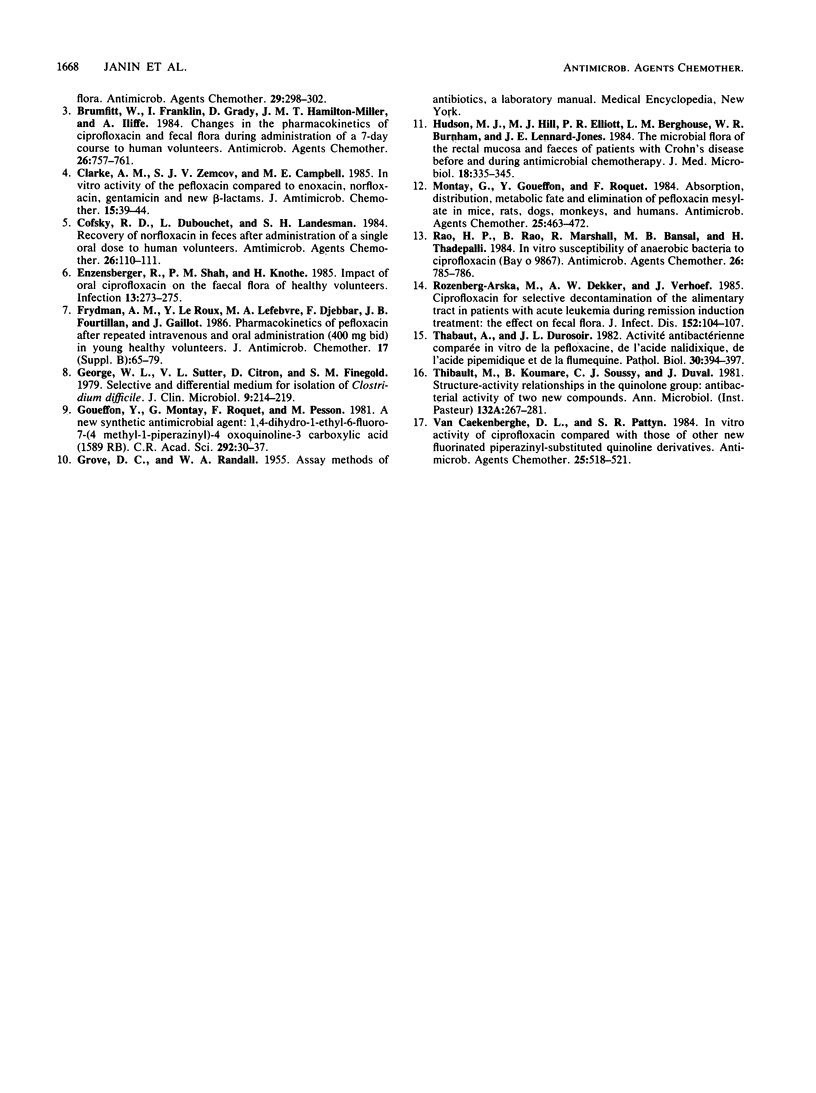Abstract
Pefloxacin, a new fluoroquinolone, was given to 10 volunteers in single 400-mg oral doses repeated at 12-h intervals during 7 days. Serum, saliva, and feces samples were collected before and at appropriate intervals after the initiation of treatment. Drug concentrations were determined by bioassay. Qualitative and quantitative analyses of the saliva and fecal floras were performed. Mean concentrations in saliva (3.46 micrograms/ml on day 1 and 7.54 micrograms/ml on day 7) were closely related to levels in serum. High concentrations of pefloxacin were found in the feces (645 micrograms/g on day 8). No modification of oral flora was observed. In the fecal flora, members of the family Enterobacteriaceae were eliminated between days 2 and 8. The alterations in streptococci and anaerobic flora were not significant; Bacteroides fragilis was more resistant to pefloxacin after treatment. Clostridium difficile was not detected, and there was no overgrowth by yeasts. No side effects were observed.
Full text
PDF



Selected References
These references are in PubMed. This may not be the complete list of references from this article.
- Brumfitt W., Franklin I., Grady D., Hamilton-Miller J. M., Iliffe A. Changes in the pharmacokinetics of ciprofloxacin and fecal flora during administration of a 7-day course to human volunteers. Antimicrob Agents Chemother. 1984 Nov;26(5):757–761. doi: 10.1128/aac.26.5.757. [DOI] [PMC free article] [PubMed] [Google Scholar]
- Clarke A. M., Zemcov S. J., Campbell M. E. In-vitro activity of pefloxacin compared to enoxacin, norfloxacin, gentamicin and new beta-lactams. J Antimicrob Chemother. 1985 Jan;15(1):39–44. doi: 10.1093/jac/15.1.39. [DOI] [PubMed] [Google Scholar]
- Cofsky R. D., duBouchet L., Landesman S. H. Recovery of norfloxacin in feces after administration of a single oral dose to human volunteers. Antimicrob Agents Chemother. 1984 Jul;26(1):110–111. doi: 10.1128/aac.26.1.110. [DOI] [PMC free article] [PubMed] [Google Scholar]
- Enzensberger R., Shah P. M., Knothe H. Impact of oral ciprofloxacin on the faecal flora of healthy volunteers. Infection. 1985 Nov-Dec;13(6):273–275. doi: 10.1007/BF01645437. [DOI] [PubMed] [Google Scholar]
- Frydman A. M., Le Roux Y., Lefebvre M. A., Djebbar F., Fourtillan J. B., Gaillot J. Pharmacokinetics of pefloxacin after repeated intravenous and oral administration (400 mg bid) in young healthy volunteers. J Antimicrob Chemother. 1986 Apr;17 (Suppl B):65–79. doi: 10.1093/jac/17.suppl_b.65. [DOI] [PubMed] [Google Scholar]
- George W. L., Sutter V. L., Citron D., Finegold S. M. Selective and differential medium for isolation of Clostridium difficile. J Clin Microbiol. 1979 Feb;9(2):214–219. doi: 10.1128/jcm.9.2.214-219.1979. [DOI] [PMC free article] [PubMed] [Google Scholar]
- Goueffon Y., Montay G., Roquet F., Pesson M. Sur un nouvel antibactérien de synthèse : l'acide éthyl-1 fluoro-6 (méthyl-4 pipérazinyl-1)-7 oxo-4 dihydro-1.4 quinoléine-3 carboxylique (1589 R.B.). C R Seances Acad Sci III. 1981 Jan 5;292(1):37–40. [PubMed] [Google Scholar]
- Hudson M. J., Hill M. J., Elliott P. R., Berghouse L. M., Burnham W. R., Lennard-Jones J. E. The microbial flora of the rectal mucosa and faeces of patients with Crohn's disease before and during antimicrobial chemotherapy. J Med Microbiol. 1984 Dec;18(3):335–345. doi: 10.1099/00222615-18-3-335. [DOI] [PubMed] [Google Scholar]
- Montay G., Goueffon Y., Roquet F. Absorption, distribution, metabolic fate, and elimination of pefloxacin mesylate in mice, rats, dogs, monkeys, and humans. Antimicrob Agents Chemother. 1984 Apr;25(4):463–472. doi: 10.1128/aac.25.4.463. [DOI] [PMC free article] [PubMed] [Google Scholar]
- Prabhala R. H., Rao B., Marshall R., Bansal M. B., Thadepalli H. In vitro susceptibility of anaerobic bacteria to ciprofloxacin (Bay o 9867). Antimicrob Agents Chemother. 1984 Nov;26(5):785–786. doi: 10.1128/aac.26.5.785. [DOI] [PMC free article] [PubMed] [Google Scholar]
- Rozenberg-Arska M., Dekker A. W., Verhoef J. Ciprofloxacin for selective decontamination of the alimentary tract in patients with acute leukemia during remission induction treatment: the effect on fecal flora. J Infect Dis. 1985 Jul;152(1):104–107. doi: 10.1093/infdis/152.1.104. [DOI] [PubMed] [Google Scholar]
- Thabaut A., Durosoir J. L. Activité antibactérienne comparée in vitro de la péfloxacine (1589 RB), de l'acide nalidixique, de l'acide pipémidique et de la fluméquine. Pathol Biol (Paris) 1982 Jun;30(6):394–397. [PubMed] [Google Scholar]
- Van Caekenberghe D. L., Pattyn S. R. In vitro activity of ciprofloxacin compared with those of other new fluorinated piperazinyl-substituted quinoline derivatives. Antimicrob Agents Chemother. 1984 Apr;25(4):518–521. doi: 10.1128/aac.25.4.518. [DOI] [PMC free article] [PubMed] [Google Scholar]


